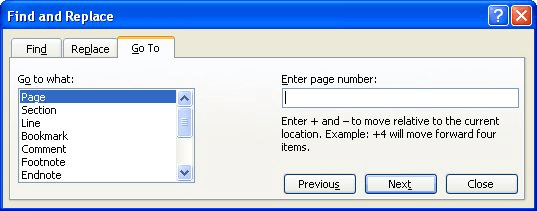Written by Allen Wyatt (last updated March 29, 2022)
This tip applies to Word 97, 2000, 2002, and 2003
If you are creating standard templates for your company, you may want to go one step further and make sure the cursor (insertion point) is positioned at a particular location whenever a new document is created that is based on the template. This can come in handy, as it ensures that the insertion point is at the proper place to begin typing in the new document.
This is a relatively easy process to do. Follow these steps:

Figure 1. The Bookmark dialog box.

Figure 2. The Go To tab of the Find and Replace dialog box.
That's it! The next time you create a document based on the template, the AutoRun macro will automatically execute, and you will jump to the designated spot.
Note:
WordTips is your source for cost-effective Microsoft Word training. (Microsoft Word is the most popular word processing software in the world.) This tip (1569) applies to Microsoft Word 97, 2000, 2002, and 2003.

Do More in Less Time! An easy-to-understand guide to the more advanced features available in the Microsoft 365 version of Word. Enhance the quality of your documents and boost productivity in any field with this in-depth resource. Complete your Word-related tasks more efficiently as you unlock lesser-known tools and learn to quickly access the features you need. Check out Microsoft 365 Word For Professionals For Dummies today!
When you save a file, the information from the start of the file is saved in the properties for the document, and can be ...
Discover MoreWant your document file names to follow a specific naming convention? Word doesn't provide a direct way to set up your ...
Discover MoreWord maintains a few pieces of personal information with each document file you save. Getting rid of this information can ...
Discover MoreFREE SERVICE: Get tips like this every week in WordTips, a free productivity newsletter. Enter your address and click "Subscribe."
2024-01-24 11:43:01
Jim Epler
Microsoft Word for Mac (Microsoft 360) doesn't permit macros to be saved in document templates, unfortunately. Otherwise, cool tip!
Got a version of Word that uses the menu interface (Word 97, Word 2000, Word 2002, or Word 2003)? This site is for you! If you use a later version of Word, visit our WordTips site focusing on the ribbon interface.
Visit the WordTips channel on YouTube
FREE SERVICE: Get tips like this every week in WordTips, a free productivity newsletter. Enter your address and click "Subscribe."
Copyright © 2026 Sharon Parq Associates, Inc.
Comments